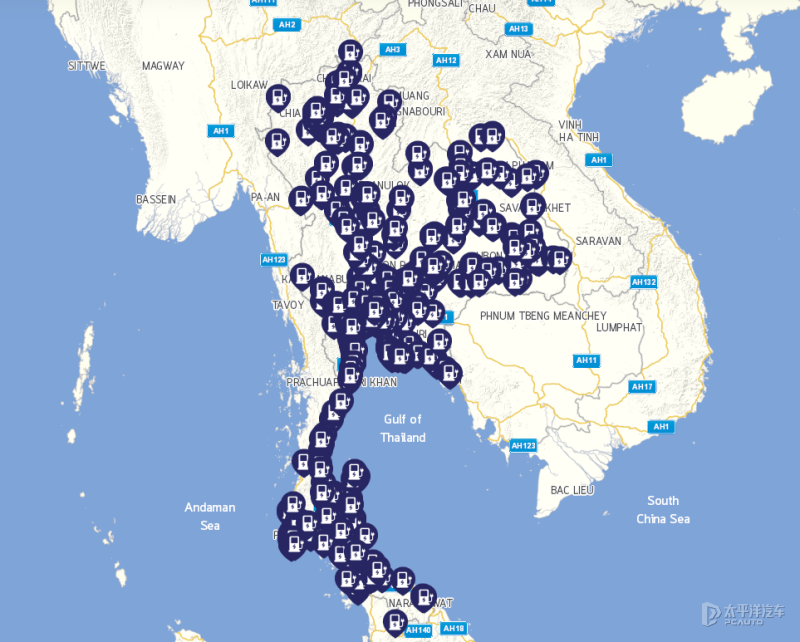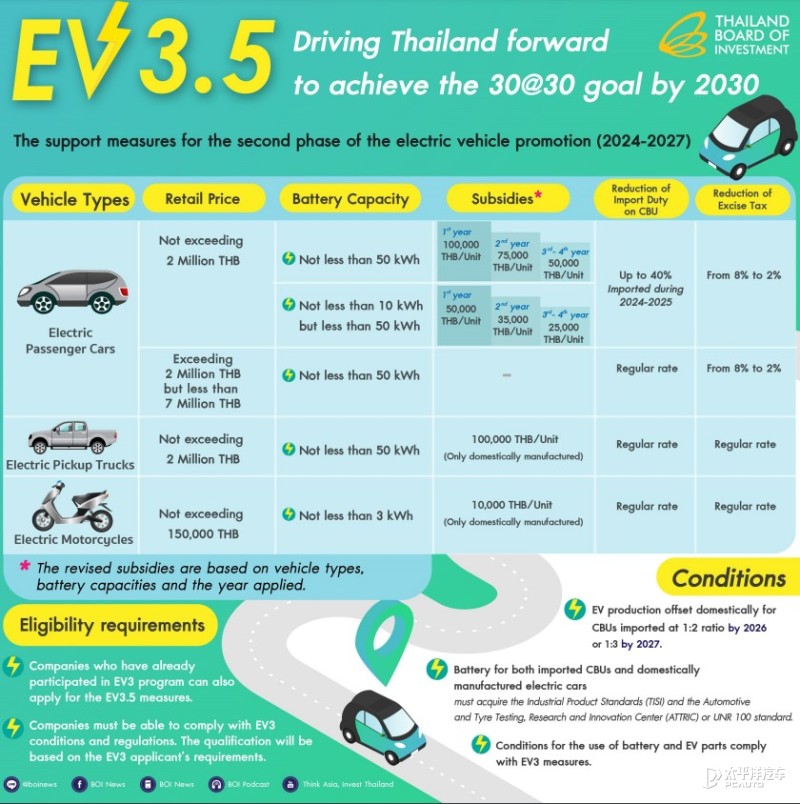The Road to Electric Vehicle Adoption in Thailand: Analysis on Battery Range, Charging Stations and Policies
 AshleyMay 01, 2024, 10:00 AM
AshleyMay 01, 2024, 10:00 AM
Thailand plans by 2030, zero-emission vehicles (ZEV) production accounts for at least 30% of the total production of motor vehicles. Besides, it continues to introduce the "EV3.5" policy after "EV3.0". This policy was officially implemented on January 1, 2024, for 4 years. The Thai government stimulates the development of Thailand's pure electric vehicle industry through several measures such as providing cash subsidies to new vehicles and reducing import tariffs and consumption taxes.

The most significant difference between new energy vehicles and traditional fuel vehicles is the power mode (that is, the mileage). The local charging pile coverage network, charging prices, electric vehicle maintenance, depreciation, and related purchase policies in Thailand all needed to be understood before buying new energy vehicles. This article will summarize the points to be aware of for new entrants of electric vehicles in Thailand to provide a purchase guide.
1. Range: clear testing standards
The standard mileage of new energy vehicles generally has four different testing standards, namely NEDC, WLTP, EPA, and CLT. Generally speaking, the WLTP test result is closer to the actual mileage, the NEDC test is relatively idealized and biased high, the EPA considers more factors and is biased low, and the CLTC is the test result based on China's actual driving conditions.
NEDC stands for New European Driving Cycle, it is also known as the "new standard European cycle test". The overall test environment is mild and idealized, and the test results will be slightly higher than the actual driving mileage.
WLTP stands for the World Light Vehicle Test Procedure. This test includes the vehicle's rolling resistance, gear position, vehicle weight (cargo, passengers), etc., into the test scope. Compared with NEDC, it has made considerable progress, and WLTP is relatively closer to the actual mileage.
EPA stands for U.S. Environmental Protection Agency. It is the current mileage testing standard of the US Environmental Protection Agency. The overall testing environment is similar to WLTP, but the EPA's testing standard has a long time, long mileage, high speed, multiple shifts, and even takes into account the impact of environmental temperature on energy consumption. Therefore, its testing results will be slightly lower than WLTP.
CLTC is CLTC-P, the full name is "China light-duty vehicle test cycle-passenger", which was developed by the China Automotive Technology Research Center (CATARC) based on the results of tests under real driving conditions in China.
2. Charging Pile Coverage: Endurance Must Know
The charging pile for new energy vehicles is equivalent to the gas station for traditional fuel vehicles, so the location of the charging pile contributes to the convenience of daily driving and long-distance driving. According to the official website of the Thai Electric Vehicle Association, the number of charging stations in Thailand is 1,479.
Before buying a new energy vehicle, you can first check the location of the charging pile through the map, which is convenient for charging the new energy vehicle, the query link is https://evat.or.th/ev-information/charge-station/index.

3. Policy: Price Advantage
BOI launched a series of subsidies and tax benefits to promote the strategic goal of achieving a 30% share of new energy vehicles by 2030, which reflects the price advantage of new energy vehicles.

In 2023, the number of new registrations of pure electric vehicles in Thailand exceeded 76,000, a significant increase from 9,678 in 2022. And the number of new registrations of all types of electric vehicles in Thailand exceeded 100,000 in 2023, an increase of 380% year-on-year. Kritsada Uttaromot, president of the Thai Electric Vehicle Association, said that in 2024, the sales of electric vehicles in Thailand are expected to rise further, with registrations reaching 150,000.
4. Car Maintenance: Protection of Three Electrical System
The maintenance of new energy vehicles includes the following five parts: battery, electric motor, reducer, braking system, and air conditioning system. Specific maintenance suggestions can be made according to the official website suggestions of the new energy vehicle brand.
·Battery: The battery of a new energy vehicle is the core component that requires regular inspection of its performance and status.
·Motor: Check the working conditions of components such as motors and electronic control systems to ensure their normal operation.
·Reducer: Regularly change the gear oil to ensure the lubrication performance of the reducer is good.
·Braking system: Check the wear and tear of components such as brake pads and brake discs to ensure the braking performance is good.
·Air conditioning system: The air conditioning system is of great importance to the comfort and endurance mileage of new energy vehicles, which needs regular inspection and cleaning.
If any infringement occurs, please contact us for deletion
Trending News

BYD Sealion 7 is not only cheaper than Tesla Model Y, what other differences do they have?
Is it better to buy the BYD Sealion 7 or the Tesla Model Y? This really makes one a bit hesitant, but before you make a decision, I recommend you take a good look at this article.

2026 Toyota Hilux Travo released, the brand-new exterior and interior are highly anticipated
If you're considering buying a Hilux, honestly, the comprehensive innovations in the ninth generation are worth waiting for. While the current model might still have some advantages in terms of reliability and price, the new model offers significant changes in terms of exterior and interior luxury, tech features, and powertrain options.

In Malaysia, which sliding door MPVs are available?
The numerous advantages of sliding door MPVs make many people fond of this type of vehicle. However, MPVs are not a mainstream choice in the car market, so many people might not know which MPVs are available domestically.

Jaecoo J7 VS Honda CR-V, which is the most worthwhile C-Segment SUV to buy
With an exterior that closely resembles a Land Rover, Jaecoo J7's sales experienced several months of rapid growth but have recently slowed down. Perhaps the market is nearing saturation, as Jaecoo J7 has already surpassed the once-dominant Honda CR-V in the C-Segment SUV category.

Which one is better, Honda City or Toyota Vios?
When choosing a compact sedan, Honda City and Toyota Vios are often two options that make people weigh repeatedly. You might be attracted to the dynamic design of the Vios but also be captivated by the City.
Popular Cars
Model Year
Car Compare
Car Photo

